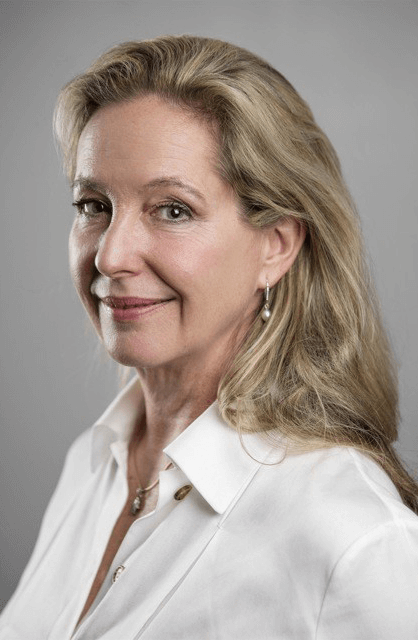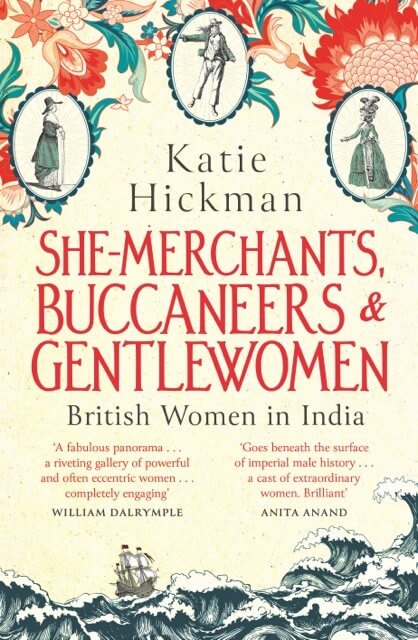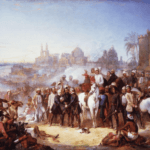BACSA’s lecture programme runs between November and June and is presented in association with the South Asia Centre, London School of Economics. Lectures are currently suspended due to the coronavirus pandemic but podcasts of most past ones can be found in the Members’ Section.
The first lecture of the current programme was given on 5 December by George Morton-Jack on ‘India’s Great War: Forgotten Personal Stories of 1914-18’and in the blogs below Rosemary Raza of BACSA reviews Katie Hickman’s lecture on 12 March on ‘She-Merchants, Buccaneers and Gentlewomen’ and Sam Goodman discusses his forthcoming one on ‘Keeping Their Spirits Up: Alcohol, Diet and Doctoring during the Siege of Lucknow’.
Katie Hickman takes a fresh look at British women in India
In the last in the BACSA series of lectures before the onslaught of the coronavirus pandemic, Katie Hickman gave a novel view of some of the British women who made the long journey to India from the 17th century. Her recent book She-Merchants, Buccaneers and Gentlewomen: British Women in India continues her interest in the history of women, which has also embraced the disparate lives of diplomatic wives and courtesans in the 18th and 19th centuries. The ‘memsahibs’ however, too often confined in that 19th-and 20th-century term to the role of husband hunters and spoilers of empire, are in particular need of study and re-evaluation.

© Steve Brown

The British engagement with India began as a trading venture in 1600 with the establishment of the East India Company, and ended with a retreat from empire in 1947. Within that long period, it is often not fully appreciated how the presence and role of women in India changed. Katie Hickman set out to put this right, in particular by focusing on the first centuries of Britain’s presence in the subcontinent. Her lecture shed fascinating light on a little-known group of women, and their motives for travelling to India. In the early days, their reasons were similar to their male compatriots—desire to improve their lot and a sense of adventure. The latter was certainly required for an eight-month voyage in a tiny ship, often battling violent storms, pirates, the French, malnutrition, illness, not to mention misogynist captains.
In 1617 an unexpected and ill-assorted group of three women set sail. One was the Christian Armenian wife of the captain, who had previously been the widow of William Hawkins, whom she had met on his embassy to the court of Jehangir. Another boarded ship as a single lady, astonished the company by producing a baby en route, and disembarked as the wife of her accompanying protector and father of the child. The third was a shrewd businesswoman, who survived the rough and tumble of life in the trading station of Surat and returned to England with a fortune made in textile purchases. Her business perspicacity was echoed by many women who held shares in the East India Company in their own right.
Britain’s toehold in India, held at the whim of Indian rulers, was considerably strengthened in 1666 with the acquisition of sovereign territory in Bombay following the marriage of Charles II to Catherine of Braganza. Now Britain needed colonists—and the role and value of women changed considerably. Married women, and later their children, were encouraged to go with their husbands to Bombay. Single women were needed too, and with the lack of suitable applicants, orphans as young as 12 from Christ’s Hospital made the long journey.
The 18th century saw a further change in Britain’s role in India. What had been a trading presence grew through war and territorial acquisition to become a huge governing structure with civilian and military cadres. Many of the women who now came to India were well educated, and shared with their menfolk a delight in Indian life and culture. But society retained its rough edge, and indeed became increasingly raffish with the rise of the nabob. Excess was rampant. There was money to be made—and women as well as men flocked to India to make the most of business opportunities of all kinds. Self-invention was also the order of the day. The shortage of women meant that deficiencies of breeding and background were overlooked in the marriage market. Here was the fishing fleet, but on a less decorous level than in later years.
Although few British women were able to penetrate Hindu and Muslim zenanas as they might have wished, there was a mutual interest and tolerance between the British and Indians which began to disappear in the early 19th century. Katie Hickman ascribed this in part to the rise of the Evangelicals. The East India Company had formerly been wary of missionaries; now their role in India was endorsed. While recognising the valuable contribution missionary women often made in fields like medicine and education, she nevertheless saw their condemnation of Indian religions as widening the gap in sympathy and understanding.
Katie Hickman was now on the brink of the memsahib in all her fierce 19th-century manifestations, though as she pointed out, later women are often misrepresented as many continued to love, understand and thoroughly enjoy India. In focusing on the early period of women’s involvement in India, she drew our attention in fascinating detail to a little-known period which underlay later developments.
After the lecture and some stimulating questions, everyone greatly enjoyed a wine reception and the chance to meet the speaker and talk further about the ever-debatable subject of the memsahib.
Dr Rosemary Raza is the author of In Their Own Words: British Women Writers and India 1740-1857
On Lockdown and Lucknow: Living through Extraordinary Events
As I imagine was true for people the world over, my plans for April were quite different to how things turned out. On 6 April I expected to be at the LSE talking to BACSA about the events of the summer of 1857 and life in Lucknow during the Indian Rebellion. Instead I found myself two weeks into lockdown along with the rest of the country adjusting to the ‘new normal’. Deprived of an audience, I did not stop thinking about Lucknow. It occurred to me what it might have been like for the British there in May 1857, their own plans similarly dashed by developments beyond their control. The more I thought about it, the more it seemed that on a human level there was not as much separating then from now, and us from them, as might first appear. Of course, we in 2020 are thankfully not subject to the same threat of violence as those within and without the walls of Lucknow as we sit in our gardens or walk in the park. The battles of the Rebellion aside, the story of Lucknow is as much about what happens to people and how they react when their expectations and understanding of the world are upended by sudden and unanticipated events.

The Relief of Lucknow, 1857, by Thomas Jones Barker, NPG 5851
© National Portrait Gallery
The prolonged and isolating nature of the Siege of Lucknow meant that much of the contemporary record comes to us through diary accounts of soldiers, surgeons and their wives published to enormous public interest after the Rebellion was suppressed. These tell us that just as with coronavirus there were rumblings on the horizon. Rumours spread throughout the central provinces of sepoy dissent about the infamous rifle cartridge greased with beef or pork tallow, offensive to both Hindu and Muslim alike, as well as baffling incidences of chapatis found in cantonments, supposedly a cryptic warning from those soon to rise. For most Lucknow diarists though, when the rebellion broke it was as if from a clear blue sky; few considered that what was happening elsewhere might soon also trouble them.
Once it became clear that the siege was to last, the residents began to take stock, obsessing over supplies of food, drink, ammunition and medical equipment. As one of the main British garrisons in the region, Lucknow was fortunately full of doctors,from apothecaries to regimental surgeons and including physicians of note, such as William Brydon, one of the few to survive the retreat from Kabul in 1842, and Joseph Fayrer who would go on to become an authority on the treatment of snake bite. Even so, the medical men at Lucknow were particularly hard pressed.For all the present talk of ‘front lines’ in hospitals across the UK, the doctors at Lucknow were part of a literal front line of defence. Those within the garrison, such as Fayrer, and those in the relief forces,such as Surgeon Anthony Dickson Home (who would win the Victoria Cross for actions at Lucknow), fought as much as they tended wounds and disease in the makeshift hospitals—a policy that might seem reckless to us now but one that indicates the need for fighting men. Similarly,many wives of soldiers and civilians were drafted into medical service, assisting with nursing and health care throughout the siege. Like the doctors and nurses of today, though the Lucknow garrison were heroic in their efforts they often lacked the essential supplies to treat their patients effectively, even resorting to bottles of champagne for makeshift pain relief before amputations.
The practical details of everyday life in Lucknow took on great importance, and diarists obsess over food and drink (or the lack thereof) throughout. Just as today, many residents tried their hand at cooking for the first time with mixed results. For every Colina Brydon who recorded with triumph that ‘some bread I made last night turned out rather well’ there was a Kate Bartrum whose only option was to cook in a copper pan that turned her dinners ‘perfectly green’. With no prospect of a home delivery or a click and collect, others made do where they could; Fayrer personally shot 150 sparrows for a curry, though had few takers when he offered it as potluck to fellow residents. Elsewhere diarists record the intense ‘strain’ as time wore on, with boredom as much of an adversary as hunger, thirst or disease, not to mention the armies outside.
Of course,the conditions of Lucknow and the coronavirus lockdown are also very different, and my comparison here does not seek to trivialise in any way the human tragedy of either event.What I hope it has done though is to bring into focus the shared uncertainty of these extraordinary periods of British history, as well as to highlight similarities in the human responses of individuals separated by time, political context and thousands of miles. We are thankfully a world away from the inequalities of British colonialism and think of ourselves as modern, more enlightened and more capable than the Victorians. As J. G. Farrell remarks in The Siege of Krishnapur, his novel on the Rebellion: ‘We look on past ages with condescension, as a mere preparation for us’. Whilst we are more than the ‘after-glow’ of them that Farrell suggests, our concerns, priorities and responses in times of emergency are often very similar, more so than perhaps we might like to think. Just as with India after the Rebellion, it is clear that life post-coronavirus will never be quite the same again.
Dr Sam Goodman, Principal Academic, Bournemouth University, is currently researching the role of alcohol in colonial medicine, military routine and Anglo-Indian culture.
